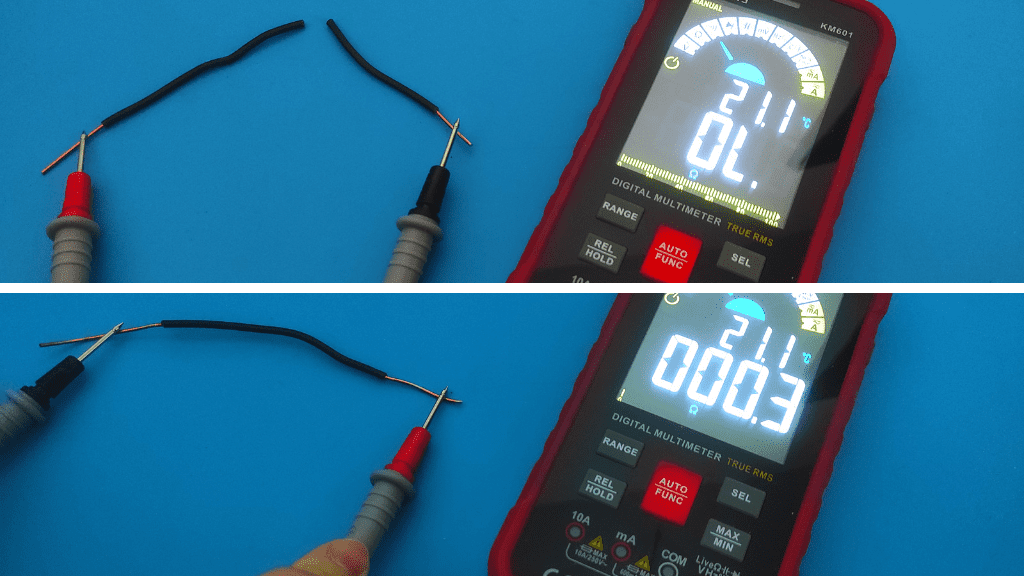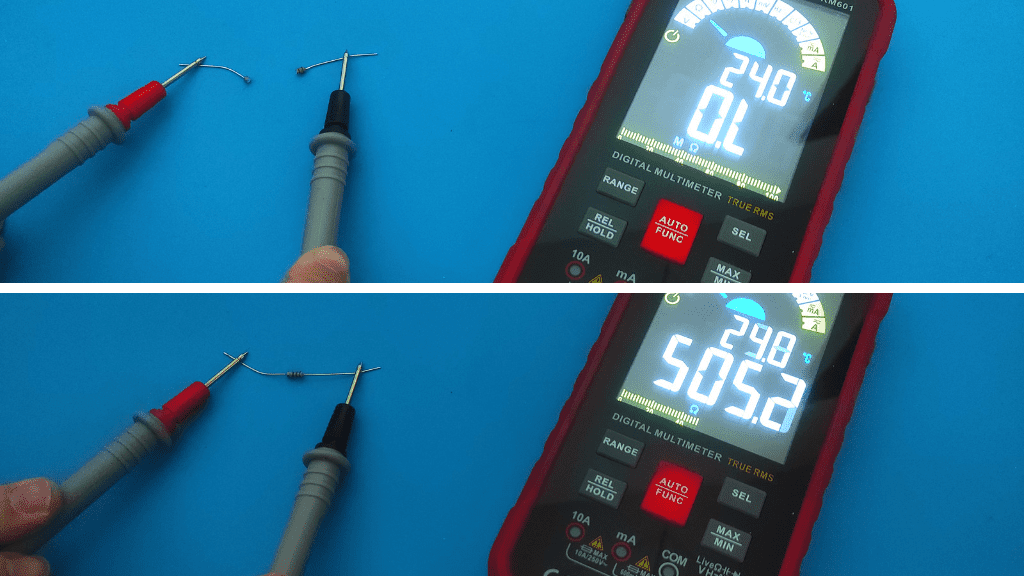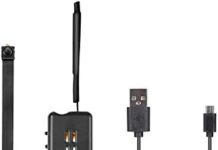WHAT DOES OL MEAN ON A MULTIMETER? Nowadays, digital multimeters are the popular choice when it comes to measuring electrical stuff. The reason is simple: they are easier to use and give you precise numbers to understand what’s going on with your electrical components.
But if you’re new to using a multimeter, there’s one thing that might confuse you. When you see the letters “OL” on the multimeter screen, it can mean different things depending on what mode you’re in.
In our article, we want to help you understand what “OL” means in different situations. We have also included what to do when you see OL on a multimeter.
So, let’s jump right in and clear up the mystery of “OL”.
OL Mean on a Multimeter Key Points Covered in the Article
- Digital multimeters are popular for measuring electrical components due to their ease of use and clear numerical readings.
- “OL” on a multimeter screen stands for “Overload” and indicates that the measured voltage or resistance exceeds the multimeter’s limit.
- In continuity mode, “OL” stands for “Open Loop” and signifies a break in the circuit.
- Understanding a multimeter’s different modes is crucial for accurately interpreting the “OL” message.
- “OL” in voltage mode means the voltage is too high for the set range, while in continuity mode, it indicates a lack of continuity.
- In resistance mode, “OL” suggests an infinite amount of resistance, obstructing the flow of electricity.
- Troubleshooting the “OL” reading involves checking range settings, probe connections, and potential multimeter issues.
- “OL” does not signify low resistance; it represents overload or open loop conditions, depending on the mode being used.
What Does Ol Mean on a Multimeter?
When you use a multimeter to measure voltage or resistance, sometimes you might see the letters “OL” on the screen. Don’t worry; it’s not an error or a secret code. “OL” actually stands for overload.
Here’s what it means: the multimeter has a limit to how much voltage or resistance it can handle.
If you’re trying to measure something that goes beyond that limit, the multimeter will say “OL” to let you know it can’t handle it. It’s like saying, “Hey, this is too much for me to handle; it’s overload.”
But that’s not the only case. When you’re testing for continuity, which means checking if there’s a complete path for electricity to flow, “OL” means something different.
It stands for Open Loop and tells you there’s a break in the circuit. It’s like saying, “Oops, there’s a gap in the path, so the electricity can’t go through.”
These are just the basics, though. Keep reading to know more.
So, before we dig deeper, it’s important for you to grasp the basics of the different modes your multimeter might have that could show you the “OL” message.
Different Multimeter Modes and Getting to Know OL Readings
When you use a multimeter to measure voltage, continuity, or resistance in a circuit, sometimes you might see the letters “OL” on the display. Don’t worry; it’s not a secret code or anything. “OL” actually stands for overload.
Let’s talk about what “OL” means in each case:
Voltage
Voltage is like the electrical pressure or power between two points in a circuit. When you measure voltage using a multimeter, you need to set it to the right range on the dial.
What OL Means When Testing Voltage?
If the multimeter shows “OL” while you’re testing voltage, it means that the voltage is too high for the range you set. It’s like saying, “Hey, this voltage is way too much for me to handle.”
Sometimes, instead of “OL,” the multimeter might show “1” if the voltage exceeds the range. That also means it’s an overload situation.
For example, if you set the multimeter to the 2V range and measure a voltage higher than 2 volts, you’ll see “OL” or “1” on the display. It’s telling you that the voltage is too high for that range.

Continuity
Continuity means that electricity can flow through a path without any breaks or gaps. To check continuity, you usually use the soundwave mode on the multimeter (if it has one).
Using the Continuity Mode
When you touch the black and red probes of the multimeter together, you should hear a beep sound. That means there’s continuity, like saying, “Yup, the path is clear for electricity to flow.”
If there’s a break or gap in the circuit, there won’t be any sound. That indicates a lack of continuity, like saying, “Oops, there’s a gap in the path; electricity can’t flow through.”
So, when you see “OL” on the multimeter, it means different things depending on what you’re measuring. It could be an overload for voltage or a lack of continuity in the circuit. Understanding these meanings will help you figure out what’s happening.
What Does OL Means When Testing Continuity?
Now, let’s talk about what happens when a circuit has a problem. When there’s something wrong, the multimeter screen will show the letters “OL,” which means Open Loop. It’s like a signal that tells us there’s a break or gap in the circuit.
Let’s imagine you’re using a multimeter to check a wire for any issues.
If the multimeter displays “OL,” it means there’s something not right with the wire between the points where you put the black and red probes. It’s like saying, “Hey, there’s a problem with the flow of electricity here.”
To help you understand this concept better, let’s use a water and hose analogy. Imagine you have a hose with water flowing through it.
Now, if there’s a break or hole in the hose, the water can’t move smoothly from one end to the other. It’s similar to an open loop in a circuit, where the electricity can’t flow continuously because there’s a gap in the path.

Now, let’s move on to resistance:
Resistance
Resistance is like the roadblock that slows down the flow of electricity in a circuit. The higher the resistance, the harder it is for the electricity to move through.
The smallest possible resistance we can have is zero (0) ohms, which means the electricity can move through without any resistance at all.
Using The Resistance Mode
When you want to measure resistance using a multimeter, you need to set the dial to the “Ohms” setting. It’s usually represented by the symbol “Ω” (kind of like a fancy horseshoe).
Just like when we measure voltage, we need to choose the right range on the multimeter. This helps us get accurate results. It’s like picking the right tool for the job.
For example, if you expect the resistance of a copper wire to be around 10 ohms, you would set the multimeter to the 20 Ohms range. It’s like adjusting the multimeter to the right level to accurately measure resistance.
If you think the resistance might be around 150 ohms, then you would choose the 200 Ohms range on the multimeter. Again, it’s about picking the range that’s closest to the resistance you’re expecting.
I hope this explanation makes it easier for you to understand what “OL” means when testing continuity and how resistance is measured with a multimeter.
What OL Means When Testing Resistance
So, when you use a multimeter, and it shows an OL reading, it means there’s a big problem. It’s like saying, “Hey, there’s something seriously wrong here.”
The OL reading tells us that there’s an infinite amount of resistance between the two points you’re testing. Resistance is like a roadblock that makes it hard for electricity to flow through.
Imagine you have a water hose, and you’re trying to spray water from one end to the other. If the hose is clear and nothing is blocking it, the water flows easily.
But if there’s something blocking the hose, like a kink or a knot, the water can’t pass through. That’s what happens with the OL reading. It’s like a big blockage in the pathway for electricity.
When the multimeter shows OL, it means there’s no proper connection between the multimeter probes and the circuit. It’s like the electricity’s path is interrupted and can’t find its way through.
Think of it this way: when you have a completely blocked pipe, no water can go through it. It’s like the water hits a wall and can’t continue. In the same way, an OL reading means the electricity hits a roadblock and can’t flow.
The multimeter uses the OL reading to let us know that there’s no way for the electricity to go through. It’s like a warning sign telling us that we need to fix something in the circuit.
So, when you see OL on the multimeter, it’s important to check if there’s a problem with the wires or connections. Something might be disconnected or broken, causing that big blockage in the circuit.
Remember, the multimeter is a tool that helps us measure and troubleshoot electrical problems. The OL reading is like its way of saying, “Uh-oh, we’ve got a major obstacle here.”

I hope this explanation makes it easier for you to understand what the OL reading means.
Solutions for Multimeter Ol Reading
When you use a multimeter, and it shows “OL” on the screen, it usually means there’s something not quite right with what you’re testing.
For example, if you’re checking a copper wire and it says “OL,” it’s telling you that the wire is broken somewhere and needs to be replaced.
The same goes for measuring voltage from a wall socket. If it shows “OL,” it means the socket is overloaded, and you should look into why that’s happening.
But here’s the thing: “OL” doesn’t always mean there’s a problem. Sometimes, it’s because of how the multimeter is set up or issues with the probes you’re using.
Let’s break it down further:
Voltage: When you’re measuring voltage, make sure the multimeter is set to the right range. If you’re expecting a reading of 240 volts, but the multimeter is set to 200 volts, it will show “OL” instead. To fix this, adjust the multimeter dial to the correct range, like 600 volts.
Continuity: If you get an “OL” reading when checking continuity, it could be because of the probes. Check that they’re clean and connected properly to the thing you’re testing. If the probes aren’t making good contact or if they’re dirty, the multimeter will display “OL.”
Resistance: When you’re measuring resistance, you’ll want to consider all the things we mentioned before. Make sure the multimeter is set to the right range, clean the probes to remove any dirt, and double-check that the probes are in the correct spots.
Here’s one more thing to remember: When you first switch the multimeter to the ohm setting (that’s the one with the funny-looking symbol that looks like an upside-down horseshoe), it will show “OL” because the probes aren’t connected yet.
Don’t worry about that. But if you connect the black probe to the red probe and you don’t hear a beep or see a reading close to zero, then there might be something wrong with the multimeter itself.
By following these steps and tips, you can tackle the “OL” reading on your multimeter and make sure you’re getting accurate measurements.
Conclusion
In conclusion, understanding the meaning of “OL” on a multimeter is essential for accurate electrical measurements. The “OL” message indicates overload or open loop conditions, depending on the mode being used. By familiarizing themselves with the different modes and troubleshooting steps, users can effectively interpret and address the “OL” reading, ensuring reliable measurements and successful troubleshooting of electrical components.
Recommendation
How to Test a Fuse With a Multimeter
How To Tell If A Fuse is Blown? Check and Replace Blown Car Fuse
What is A Starter in A Car? Purpose, Limitations, & Improvements of a Car Starter
Importance of Knowing How To Use a Jump Starter
Frequently Asked Question
Does OL Mean Low Resistance?
No, OL doesn’t mean low resistance. OL stands for “overload.” When you see OL on the multimeter, it actually means the resistance is very high or infinite. It’s like when you have a super tight door that doesn’t let any air pass through.
In this case, the multimeter is telling you that the resistance is too high to measure with the range you have set. To fix this, you can adjust the multimeter to a higher range that can handle the resistance you’re trying to measure.
What Do 0.00 Ohms Mean?
When the multimeter shows 0.00 ohms, it means there is no resistance in the circuit. It’s like having a wide-open door that lets air flow through easily. This is a good thing when you want electricity to flow smoothly without any obstacles.
It indicates that the circuit is closed without any breaks or interruptions. It’s like having a clear path for the current to travel. This is usually the case when you’re measuring conducting materials that allow electricity to pass through easily.




